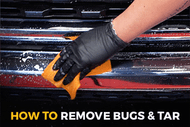How To Remove Bugs and Tar
30th Jan 2025 @ 10:14 AM
Why Bug Removal is Essential
Bug splatter on your car’s front bumper and hood isn’t just an eyesore—it’s highly corrosive. As insect remains decompose, they release enzymes that break down their carcasses. Unfortunately, these same enzymes also eat away at your vehicle’s clear coat and paint, leading to unsightly etching and long-term damage.
Other Sticky Contaminants That Harm Your Car’s Paint
In addition to bug residue, your vehicle regularly encounters tar, tree sap, and bird droppings—all of which can severely damage the paint if left untreated. Removing these contaminants as soon as possible is key to maintaining your car’s finish.
Best Methods for Bug & Tar Removal
Step 1: Quick Clean for Fresh Stains
For newly accumulated bugs or tar, use a microfiber towel and a quick detailer spray to gently wipe the paint clean. This method is ideal as it removes contaminants without stripping away any protective wax.
Step 2: Use a Bug Remover for Stubborn Stains
If the quick clean doesn’t work, it’s time for a specialized Bug Remover spray. These products soften bug splatter and loosen its bond with your car’s surface. Unlike harsher solvents, Bug Removers do not dissolve bugs aggressively, making them a safe option for paint and glass.
For more stubborn spots, consider using a bug and tar remover, which is a stronger cleaning solution designed to dissolve tough residues. These cleaners are highly effective at breaking down sticky grime, but they do remove existing wax protection. Fortunately, modern spray waxes and sealants make it easy to reapply a protective layer in minutes—just spray, spread, and wipe.
Step 3: Deep Cleaning for Heavy Bug Build-Up
If your vehicle is covered in bug splatter—common during love bug season in Florida—it’s best to wash your car thoroughly. While washing, use a scrub sponge with a honeycomb texture to lift stubborn bug remains from the paint. Scrubbing in a gentle back-and-forth motion ensures effective removal without scratching the surface.
Another powerful tool for bug and tar removal is detailing clay. Originally designed for removing paint overspray, detailing clay is highly effective at lifting tree sap, tar, and bugs. To use it:
- Apply a clay lubricant spray to the affected area.
- Glide the detailing clay bar back and forth. Initially, it will grab the surface, but as it picks up contaminants, it will begin to glide smoothly.
- If working on a large area, reshape the clay bar frequently to expose a clean section.
Pro Tip: Detailing clay is also safe for glass and metal surfaces! Just ensure you use plenty of lubricant to avoid friction-related damage.
How to Prevent Bug and Tar Build-Up
After removing all contaminants, apply a high-quality wax or paint sealant. This protective layer creates a slippery surface, making it harder for bugs, tar, and sap to adhere. Even if they do stick, their bond will be significantly weaker, allowing for easy removal with a quick detailer.
Final Thoughts
Regular maintenance and proper cleaning techniques are key to preserving your vehicle’s paintwork. By using the right products—like bug removers, detailing clay, and paint sealants—you can keep your car’s exterior spotless and protected from long-term damage. Follow this guide to maintain a bug-free, glossy finish all year round!

